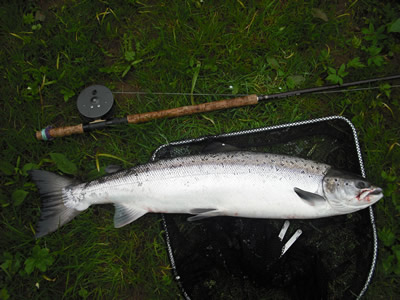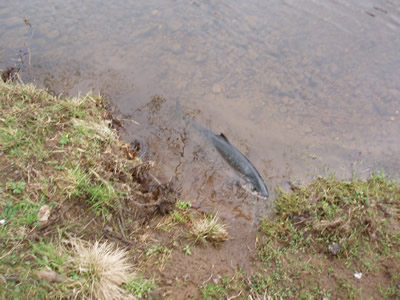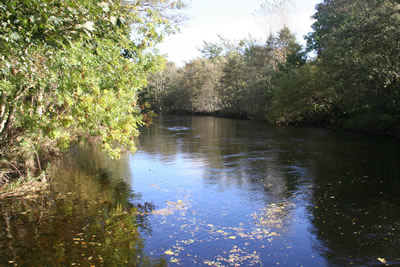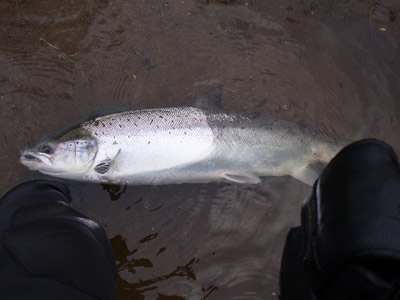Some of our blog readers have asked me to write something about tactics and the most suitable tackle for fishing the 24 pools of Finavon Castle Water.
The first thing is to consider what kind of of river the South Esk is. Understanding the nature of the river and its seasonal differences provides the basis of how we fish. The South Esk is a good, medium-size salmon river with the prospect of catching a fresh run salmon from early April to the last day of October. The grilse run should be much better than it is, and it is obvious from the river’s catch statistics that the reason for poor grilse returns is the nets operating to the south of Montrose.
The River also has a great reputation as a sea trout river and there are signs, fragile perhaps but certainly present, that sea trout runs are returning to their former abundance. If that happens we could be seeing annual sea trout catches at FCW of 200 to 300. While not exactly a spate river in the way that some Scottish west coast rivers are, the South Esk does depend on a good flow of water to optimise the chances of salmon being caught. Normally the water is clear, running over fine gravel at Finavon and in low water is absolutely gin-clear. But in a spate the river can get very dirty and takes at least two days to clear. For a few days afterwards the water stays peat stained, gradually clearing from bovril to dark sherry to Speyside malt and back to gin again. Fishermen need to adapt to these changing conditions.

This 15lbs salmon was caught (& returned) in Indies Pool in April 2010. This method of dealing with & photographing fish, that are then returned, is not good practice. Ideally fish should be photographed in the net and, if possible, without being lifted out of the water. If we are going to maximise the chances of these valuable, genetically distinct, spring salmon getting into the upper river to lay their eggs in the winter, we need to treat them much better than we are at present. This salmon should never have been taken out of the water, and certainly not laid on the bank for the photograph. Any abrasion or contact with clothing, sand or grass out of the water will damage the slime envelope and open the fish to the risk of disease. Handling fish reduces their chances of survival.
Spring salmon fishing. In April and May – we usually (but not always; e.g. May 2010) have good water levels which allow the spring salmon to disperse throughout the system quickly. Now that all the major obstructing dykes have been removed, fish can swim freely upriver. The only exception is Kinnaird Dyke just downstream of Brechin, which still holds fish back in very cold water conditions. But even Kinnaird is much improved, thanks to a brilliant adjustment made by civil engineer, Colin Carnie, with the result that for most of the season the dyke poses no problems for ascending fish. Once the first salmon arrive in FCW pools we start to see the occasional splash of a head & tailing fish, or a flash of a silver flank beneath the surface of a deeeper pool, and sometimes we see or hear the flip of a tail as a running fish briefly advertises its presence as it runs through a stream at the head of a pool.
These beautiful salmon (see photo above) are a bit easier to catch than salmon that run later in the year. Easier they may be, but not as easy as some fisheries managers claim when they say that angling in the spring can account for upwards of 25% of the salmon in the river. After living on and fishing the South Esk for many years, and judging by the numbers of fish seen in FCW pools, my assessment is that the proportion is more like 5%. In very cold heavy river conditions it is sometimes best to fish with a minnow or rapala, with barbless double, not treble, hooks. A 2.5″ brown and gold devon is ideal.
My own preference is to fish with fly in all but the most demanding conditions. For these early fish the fly needs to be a few inches beneath the surface, fished steadily and searchingly in the cheeks and jowls of the streams and cast ‘square’ with a belly in line line in the pools and tails. Salmon are top-line predators and can be attracted by the fly moving quite quickly. In slower water, by casting across the river at right angles and letting a line belly develop, the fly moves atttractively and at speed across the quieter water in a similar way to the backing-up method used on rivers like the Helmsdale and Thurso. Very often, in the tail of Milton Beat’s Lower Boat Pool for example, a fish will be drawn across from the gap under the ash tree on the north bank to take the fly midstream just above the cauld (which at FCW we call ‘RPJs’ – Riffle Pool Join!). It is very unusual for a spring salmon caught in this way to be badly hooked: the hook is usually embedded in the ‘scissors’.
The fly. My preference is the ‘Finavon Whisp’ (see photo below) which I have developed over the years as a general purpose fly for fishing Finavon’s pools in all conditions. In the spring months I use the Finavon Whisp in sixes 6 & 8 and dress them a bit more heavily than the one in the photograph. I also vary the colouring, ranging from very bright orange or yellow hair in the spring to darker colours – even black – on smaller hooks in the low water of summer. Ideally, fishing in April and May in good spring water levels, as we should get in 2011, a 13′ rod with intermediate line and slow sinking leader and a size 6 or 8 Finavon Whisp is all you need to fish for our spring salmon. Don’t expect the pools to be brimfull of fish,but you can expect to see fish and perhaps connect with one or two. In May 2008 I was on the river when a run came through and I caught four in the day using exactly the fly and method I have described. In fact, if the fish are in the mood, I think they will take any fly within reason. The most important factors in attracting a spring salmon on the South Esk are the depth, speed and angle of presentation of the fly, but above all the persistence of the angler. The moral is ‘Keep fishing’ and think laterally!

The Finavon Whisp. I think of this fly as an impression rather than a statement. When developing it I designed it with the clear water of the South Esk in mind. There are doubtless more beautiful, well-made flies on the counters of tackle shops throughout the land, but I doubt that there is a fly that has been designed with just one little river in mind, as the Finavon Whisp has for the South Esk. The main features of the fly are the relatively sparse squirrel hair tail, the jungle cock cheeks and the silver hook. Those three features, combined with the overall shape of the fly, with the strands of dyed hair extending well beyond the hook bend, are intended to give the fish a fleeting reminder of things it may have eaten in the marine phase of its life (the ‘Gallery of marvels’). Taking the aggressive and territorial nature of the salmon into account, the Finavon Whisp also has the intrusive quality of something strange and yet familiar entering the space of the fish. The fly is designed to induce a visceral response or, fished delicately just below the surface on a summer’s evening, invite the fish to see it as a memory of food. I really don’t think that the colour of the fly matters much, but the weight (of the hook) and the shape are all-important. As the individual strands of hair flicker against the resistance of the water and the jungle cock adds to the impression of life, it is important that the fly is fished at speed. Above all else the Finavon Whisp is an attractor, inviting aggression, curiosity and a visceral reaction all at the same time. It is a fly of ambiguity, inviting confusion and response. It is a fly for clear water and can be tied on single or double hooks. It is not patented, nor am I jealous of anyone improving on my crude design, but I do invite my guests and visitors to try it out. Tight lines!

This is a 6lbs cock grilse caught on a Finavon Whisp in low water at dusk in Willows; for me the essence of fly fishing for salmon. Compare this experience with harling for salmon in a Tay dub in March (with the ghillie doing all the work!). They both qualify as fly fishing for salmon. Chacun a son gout!
Summer salmon and grilse. In high autumn water levels a similar method to spring fishing can be successful. In a big summer spates I like to fish the tails of the pools, which is often where all the action is. In August 2007 we had 19 salmon in a day, mainly from the tail of the Boat Pool. Indies, Haughs, Red Brae and House Pool can all be productive in such conditions. The really challenging fishing in the warmer months is when the water is lowish. This is the time when good fieldcraft comes into play. The fisherman who uses very small flies – again a lightly tied Finavon Whisp on a size 10 or 12 silver hook – and fishes with precision and delicacy, is in with a good chance of success. In low water the streams come into play, and favourite places are Bridge Pool, Tyndals, the Flats, Craigo and Red Brae Streams, Beeches, Indies, Tollmuir and House Pool, all of which hold fish throughout the summer months. As the light fades the chances of a grilse or sea trout increase, but more about sea trout in another blog.
Autumn salmon. In September and October there are usually good numbers of salmon in all FCW pools. The method of catching them isn’t very different from the spring except that the induced take becomes even more important. Therefore, moving the fly – and keeping it moving – is absolutely essential. The ‘flickering’, illusive quality of the Finavon Whisp, modified in terms of size, weight and colour, and perhaps dressed a bit more extravagantly, comes into its own and I suspect often encourages a salmon to react that might have had its fishy mind on other things!
Do e-mail me Colonsay@hotmail.com if you have any questions or thoughts about fishing the fly at Finavon. One of the methods I have not mentioned is nymphing for salmon and grilse in dead-low summer conditions, but I can do that when I write about fishing for sea trout in a later blog.
TA
 Today, Monday 14th March, we had our second salmon of the season. This fish was an estimated 11bs of sea-liced fresh spring salmon, hard in the flesh, bright silver and simply the most beautiful salmon imaginable. I know the photo doesn’t do justice to the fish, but at least it does demonstrate that we are trying hard not to remove fish from the water before releasing them! It was caught by Derek Strachan on a one inch Willie Gunn in the middle section of Melgund Pool (Indies Beat) fishing from the North bank, and was safely released without any need to bring the fish ashore.
Today, Monday 14th March, we had our second salmon of the season. This fish was an estimated 11bs of sea-liced fresh spring salmon, hard in the flesh, bright silver and simply the most beautiful salmon imaginable. I know the photo doesn’t do justice to the fish, but at least it does demonstrate that we are trying hard not to remove fish from the water before releasing them! It was caught by Derek Strachan on a one inch Willie Gunn in the middle section of Melgund Pool (Indies Beat) fishing from the North bank, and was safely released without any need to bring the fish ashore.



